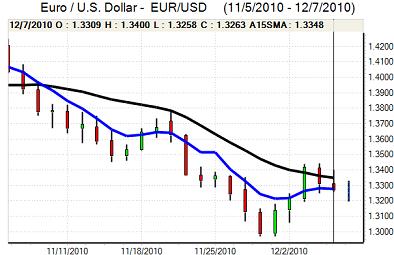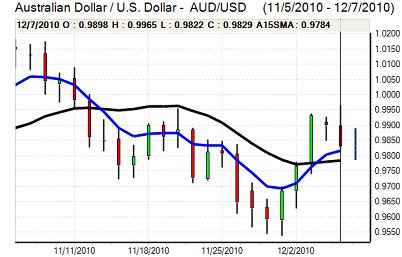EUR/USD
The Euro initially held a firm tone in Europe on Tuesday, but there was a sharp reversal in trends during the US session.
There was optimism that President Obama’s proposals to broker a deal over an extension of tax cuts could bolster growth within the US economy and this was important in pushing US Treasury yields sharply higher which also helped support the dollar, although market positioning is also likely to have been important.
There was also an increase in consumer credit for the second successive month which will create some optimism over near-term consumer spending trends and a potential easing in the credit restrictiveness seen over the past 2 years. Greater confidence in US growth prospects will increase the potential for increased investment inflows, although it will also pose very important longer-term structural risks.
The US developments illustrated the sharp divisions between US and Euro-zone policies with many Euro members tightening fiscal policy in an attempt to narrow budget deficits. The Irish government presented its austerity budget in parliament, presenting a EUR6bn package to cut the deficit over four years. There will be a series of votes on budget proposals with the government securing initial approval in Tuesday’s votes.
The Irish developments failed to provide a boost to the Euro with markets still fearing a contagion effect and medium-term instability for the Euro area, especially with persistent friction between member countries. The Euro failed to move above the 1.34 level against the dollar and retreated to lows near 1.3220 as markets took an optimistic tone towards the US stance.

Source: VantagePoint Intermarket Analysis Software
Call now and you will be provided with FREE recent forecasts
that are up to 86% accurate * 800-732-5407
If you would rather have the recent forecasts sent to you, please go here
Yen
The dollar found support on dips towards 82.50 against the yen on Tuesday and accelerated higher in US trading as the yen weakened sharply. There was a spike higher in US yields which helped underpin the dollar and it rose to a high close to 83.75 in early Asian trading on Wednesday. The Japanese currency failed to gain any support from a decline in commodity-related currencies as the US dollar secured wide-ranging gains.
The Japanese data was generally weaker than expected with a 1.4% decline in core machinery orders while there was a contraction in bank lending for the 21st consecutive month. The government was optimistic over the outlook, but underlying confidence is likely to remain generally weak and this will maintain pressure for yen gains to be resisted.
Sterling
Sterling hit resistance close to 1.5820 against the US dollar on Tuesday and had a weaker tone in New York with lows near 1.5725, although this was a function of dollar gains rather than any selling pressure on the UK currency and it advanced to near 0.84 against the Euro.
The UK economic data had a slightly positive tone with a higher than expected increase in manufacturing output for October, although there was a decline in industrial production as a whole.
The NIESR estimated that GDP growth was 0.6% in the three months to November which was slightly higher than the previous estimate and will reinforce hopes for a robust fourth-quarter performance.
The positive Sterling impact is still likely to be offset by unease over the first quarter of 2011 when there is liable to be a sharp slowdown.
Sterling will continue to gain some degree of protection from underlying fears surrounding the Euro-zone. The situation is still complex as there remains a risk that Sterling will get dragged into a wider loss of confidence surrounding European economies and currencies.
Swiss franc
The Euro was broadly resilient against the franc during Tuesday with a move to test resistance above the 1.31 level as defensive flows eased to some extent following the Irish budget presentation. The dollar was able to take advantage of the subdued franc tone on the crosses and pushed to a high near 0.99 in Asia on Wednesday.
If there is a greater focus on pro-growth currencies and improved risk conditions then defensive demand for the franc will tend to weaken. The currency should still gain firm support on an underlying lack of confidence surrounding the Euro-zone and selling pressure within Europe should be contained

Source: VantagePoint Intermarket Analysis Software
Call now and you will be provided with FREE recent forecasts
that are up to 86% accurate * 800-732-5407
If you would rather have the recent forecasts sent to you, please go here
Australian dollar
The Australian dollar hit a peak above 0.9960 against the US currency on Tuesday, but was unable to make a push towards parity and there was a rapid reversal in US trading. A squeeze on short US dollar positions helped trigger a sell-off in the Australian dollar which hit a low just above 0.98 in Asia on Wednesday
The currency should gain some protection if there is a sustained improvement in international risk appetite. In contrast, underlying confidence in the domestic economy is liable to be weaker, although the latest home loans data was slightly stronger than expected.



